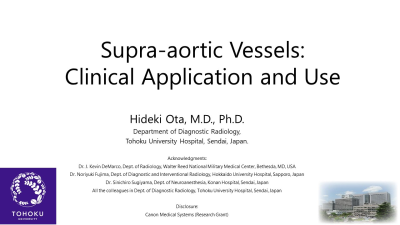Weekend Educational Session
Cardiovascular MRI: The Vasculature
Session Topic: Cardiovascular MRI: The Vasculature
Session Sub-Topic: Cardiovascular MRI: The Vasculature
Weekend Course
ORGANIZERS: Tim Leiner, Bernd Wintersperger
| Sunday Parallel 2 Live Q&A | Sunday, 9 August 2020, 15:00 - 15:30 UTC | Moderators: Vascular MRA Principles: M. Eline Kooi & Shuo Zhang |
Skill Level: Basic to Intermediate
Session Number: WE-29
Overview
This course will review essential components of routine vascular MR imaging, including accepted and cutting-edge approaches to vascular morphology, function, and dynamics as highlighted in various clinical applications.
Target Audience
Clinicians and physicists/scientists interested in evaluation of vascular pathologies to understand the clinical needs and technical foundations of vascular MR imaging, as well to gain an overview of research promises with transition into broader clinical practice.
Educational Objectives
As a result of attending this course, participants should be able to:
- Explain the technical foundation of vascular MR imaging;
- Define the different roles of morphologic and functional vessel parameters; and
- Develop adequate imaging protocols for basic vascular exams in clinical routine and research applications.
| Vascular MRA Principles | ||
| Contrast Agents for Vascular Exams: Practical Use & Safety Aspects
Jeffrey Maki
|
||
| Contrast-Enhanced MRA Techniques: Basic Techniques & Principles
Giles Roditi
|
||
| Non-Contrast-Enhanced MRA Techniques: Basic Techniques & Principles
Ioannis Koktzoglou
|
||
| Vascular MR Imaging: Applications | ||
| Thoraco-Abdominal Vessels: Clinical Application & Use
Joanna Escalon
|
||
| Vessel Wall Imaging: Substrate Visualization Beyond Luminography
Rui Li
|
||
 |
Supra-Aortic Vessels: Clinical Application & Use
Hideki Ota
In the clinical settings, conditions in supra-aortic vessels include anatomical variants, steno-occlusive diseases, aneurysms, vasculitis, and shunt diseases. Luminal and vessel-wall morphology, and hemodynamics should be evaluated according to the purpose of imaging exams. TOF MRA is the standard technique. However, in-flow-effect related pitfalls should be recognized. Ultrashort TE MRA is an alternative especially for post-interventional evaluation. Contrast-enhanced MRA allows for improved luminal and vessel-wall contrast as well as hemodynamics. Arterial spin labeling technique can be also used for the evaluation of hemodynamics. This session will introduce MR technique and image findings based on various conditions in supra-aortic vessels.
|
|
| Vascular MRA Principles | ||
| Cardiovascular Flow imaging: Basic Principles to Advanced Applications
Tino Ebbers
Blood flow is crucial in the development, diagnosis and treatment of many cardiovascular diseases. For many years, two-dimensional (2D), one-directional, time-resolved flow MRI has been the technique of choice. Nowadays, fast 4D flow MRI sequences exist on all modern MR systems and several commercial analysis software solutions are available. The challenge is to selected the most promising and relevant parameters for the research or clinical question at hand, and to obtain these with sufficient quality in a short acquisition and analysis time.
|
||
| Vascular MR Imaging: Applications | ||
| Peripheral Vessels: Clinical Application & Use
Jeremy Collins
|
||

 Back to Program-at-a-Glance
Back to Program-at-a-Glance Watch the Video
Watch the Video Back to Top
Back to Top